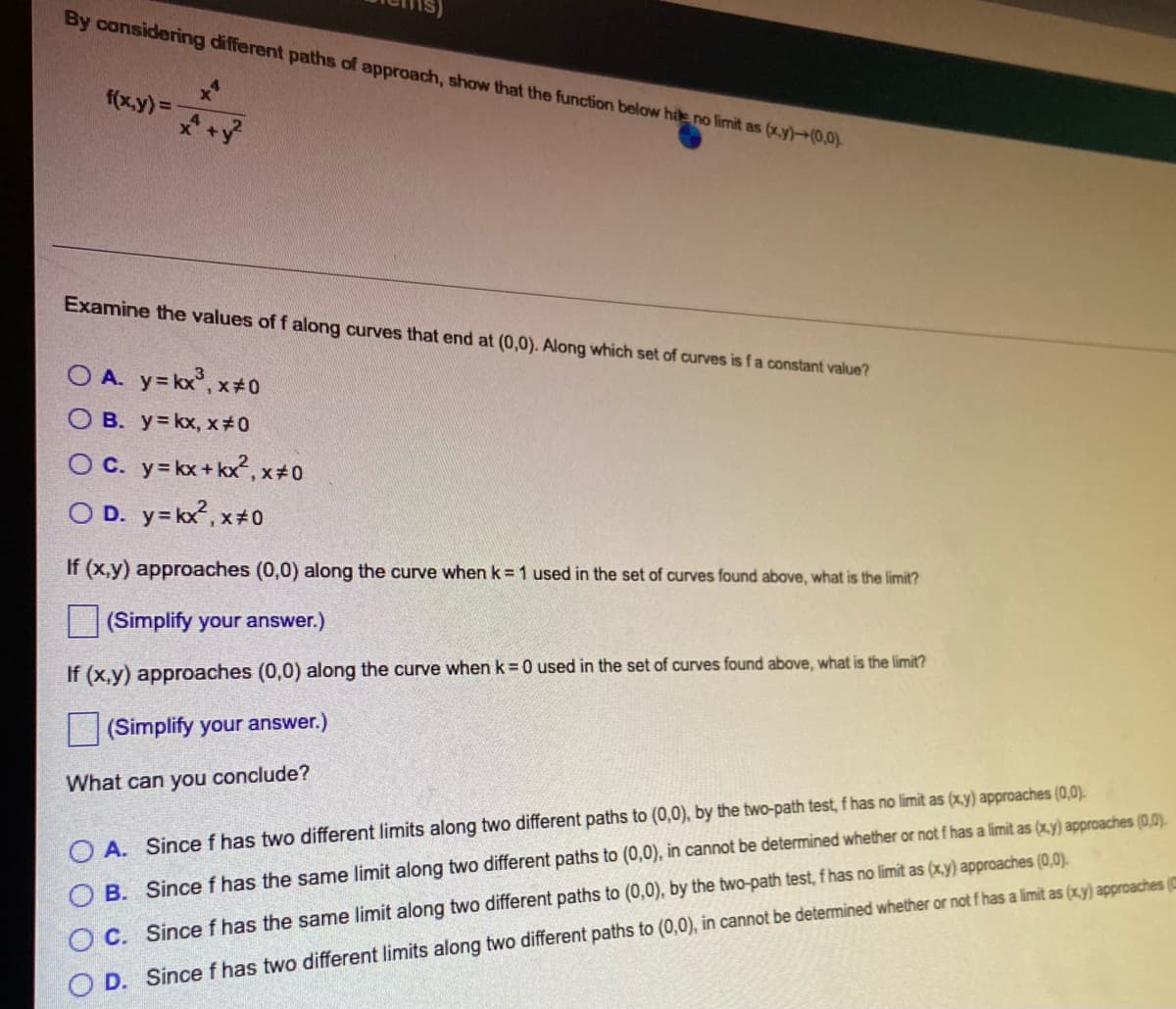By considering different paths of approach, show that the function below hile no limit as (x,y)-(0,0). f(x,y) = x+y² Examine the values of f along curves that end at (0,0). Along which set of curves is f a constant value? OA. y=kx, x=0 OB. y = kx, x#0 OC. y=kx+kx, x#0 OD. y=kx², x#0 If (x,y) approaches (0,0) along the curve when k = 1 used in the set of curves found above, what is the limit? (Simplify your answer.) If (x,y) approaches (0,0) along the curve when k = 0 used in the set of curves found above, what is the limit? (Simplify your answer.) What can you conclude? OA. Since f has two different limits along two different paths to (0,0), by the two-path test, f has no limit as (x,y) approaches (0,0). OB. Since f has the same limit along two different paths to (0,0), in cannot be determined whether or not f has a limit as (x,y) approachem C. Since f has the same limit along two different paths to (0,0), by the two-path test, f has no limit as (x,y) approaches (0,0). D. Since f has two different limits along two different paths to (0,0), in cannot be determined whether or not f has a limit as (x,y) appro
By considering different paths of approach, show that the function below hile no limit as (x,y)-(0,0). f(x,y) = x+y² Examine the values of f along curves that end at (0,0). Along which set of curves is f a constant value? OA. y=kx, x=0 OB. y = kx, x#0 OC. y=kx+kx, x#0 OD. y=kx², x#0 If (x,y) approaches (0,0) along the curve when k = 1 used in the set of curves found above, what is the limit? (Simplify your answer.) If (x,y) approaches (0,0) along the curve when k = 0 used in the set of curves found above, what is the limit? (Simplify your answer.) What can you conclude? OA. Since f has two different limits along two different paths to (0,0), by the two-path test, f has no limit as (x,y) approaches (0,0). OB. Since f has the same limit along two different paths to (0,0), in cannot be determined whether or not f has a limit as (x,y) approachem C. Since f has the same limit along two different paths to (0,0), by the two-path test, f has no limit as (x,y) approaches (0,0). D. Since f has two different limits along two different paths to (0,0), in cannot be determined whether or not f has a limit as (x,y) appro
Chapter3: Functions
Section3.3: Rates Of Change And Behavior Of Graphs
Problem 2SE: If a functionfis increasing on (a,b) and decreasing on (b,c) , then what can be said about the local...
Related questions
Question
answer quickly for instant upvote

Transcribed Image Text:By considering different paths of approach, show that the function below hile no limit as (x,y)-(0,0).
f(x,y) = x+y²
Examine the values of f along curves that end at (0,0). Along which set of curves is f a constant value?
OA. y=kx, x=0
OB. y=kx, x#0
OC. y=kx+kx, x#0
OD. y=kx², x#0
If (x,y) approaches (0,0) along the curve when k = 1 used in the set of curves found above, what is the limit?
(Simplify your answer.)
If (x,y) approaches (0,0) along the curve when k = 0 used in the set of curves found above, what is the limit?
(Simplify your answer.)
What can you conclude?
OA. Since f has two different limits along two different paths to (0,0), by the two-path test, f has no limit as (x,y) approaches (0,0).
OB. Since f has the same limit along two different paths to (0,0), in cannot be determined whether or not f has a limit as (x,y) approaches (0,0).
C. Since f has the same limit along two different paths to (0,0), by the two-path test, f has no limit as (x,y) approaches (0,0).
D. Since f has two different limits along two different paths to (0,0), in cannot be determined whether or not f has a limit as (x,y) approaches (
Expert Solution
This question has been solved!
Explore an expertly crafted, step-by-step solution for a thorough understanding of key concepts.
Step by step
Solved in 2 steps with 2 images

Recommended textbooks for you

